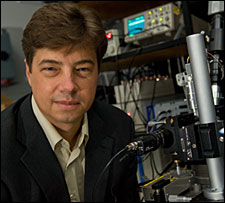
Nanoplasmonic Devices Funded
BELFAST, Northern Ireland, and LONDON, Sept. 4, 2009 -- Queen's University Belfast and Imperial College London will establish a research program on the fundamental science of nanoplasmonic devices under a new £6 million (about $9.8 million) grant from the Engineering and Physical Sciences Research Council (EPSRC) that was announced this week.
Nanoplasmonic devices' key components are tiny nanoscale metal structures - more then 100 times smaller than the width of a human hair - that guide and direct light. The structures have been tailor-made to interact with light in an unusual and highly controlled way. This means they could one day be used to build new kinds of superhigh-speed optical computers that process information using light signals instead of the electric currents.

Professor Anatoly Zayats of the School of Maths and Physics at Queen's University Belfast, who is beginning work on a new £6m project to develop 'super-fast computers' with colleagues at Imperial College London. (Image: Copyright ©Queen's University Belfast)
The researchers are developing a raft of new metallic devices including tiny nanoscale sources of light, nanoscale waveguides to guide light along a desired route, and nanoscale detectors to pick up the light signals.
Similar approaches may also help in the development of devices for faster Internet services.
"This is basic research into how light interacts with matter on the nanoscale. But we will work together with and listen to our industrial partners to direct research in the direction that hopefully will lead to new improved products and services that everyone can buy from the shelf," said professor Anatoly Zayats of Queen’s University’s Centre for Nanostructured Media, who leads the project.
“This is an exciting step towards developing computers that use light waves, not electrical current, to handle data and process information. This will also open the door to a world of possibilities in scientific fields at the interface with the biosciences, and perhaps even in the world of personal computing,” added professor Stefan Maier, who leads the research team at Imperial.
The project is also supported by Intel, Seagate, Ericsson, Oxonica, IMEC and the National Physics Laboratory.
For more information, visit: www.qub.ac.uk/
Published: September 2009